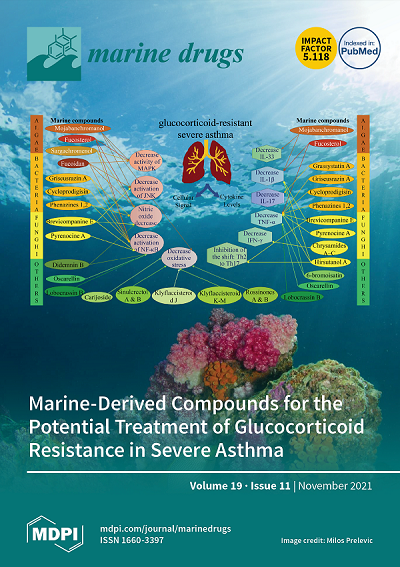Identification and Characterization of a Highly Active Hyaluronan Lyase from Enterobacter asburiae
IF 4.9
2区 医学
Q1 CHEMISTRY, MEDICINAL
引用次数: 0
Abstract
Hyaluronic acid (HA) is a well-known functional marine polysaccharide. The utilization and derivative development of HA are of great interest. Hyaluronan lyase has wide application prospects in the production of HA oligosaccharides and lower molecular weight HA. In this study, a strain of Enterobacter asburiae CGJ001 with high hyaluronan lyase activity was screened from industrial wastewater. This strain exhibited an impressive enzyme activity of 40,576 U/mL after being incubated for 14 h. Whole genome sequencing analysis revealed that E. asburiae CGJ001 contained a cluster of genes involved in HA degradation, transport, and metabolism. A newly identified enzyme responsible for glycosaminoglycan degradation was designated as HylEP0006. A strain of E. coli BL21(DE3)/pET-22b(+)-hylEP0006 was successfully constructed. HylEP0006 exhibited optimal degradation at 40 °C and pH 7.0, showing a high activity of 950,168.3 U/mg. HylEP0006 showed specific activity against HA. The minimum degradation fragment of HylEP0006 was hyaluronan tetrasaccharides, and HylEP0006 could efficiently degrade HA into unsaturated disaccharides (HA2), with HA2 as the final product. These characteristics indicate that HylEP0006 has a potential application prospect for the extraction and utilization of hyaluronic acid.阿斯布氏肠杆菌高活性透明质酸溶解酶的鉴定和特征描述
透明质酸(HA)是一种著名的功能性海洋多糖。HA 的利用和衍生品开发备受关注。透明质酸裂解酶在生产 HA 低聚糖和低分子量 HA 方面具有广泛的应用前景。本研究从工业废水中筛选出一株具有高透明质酸酶活性的阿斯布里亚肠杆菌 CGJ001。全基因组测序分析表明,E. asburiae CGJ001 包含一组参与 HA 降解、运输和代谢的基因。一种新发现的负责糖胺聚糖降解的酶被命名为 HylEP0006。成功构建了大肠杆菌 BL21(DE3)/pET-22b(+)-hylEP0006 菌株。HylEP0006 在 40 °C、pH 值为 7.0 的条件下表现出最佳降解效果,活性高达 950,168.3 U/mg 。HylEP0006 对 HA 具有特异性活性。HylEP0006 的最小降解片段是透明质酸四糖,HylEP0006 能将 HA 有效降解为不饱和二糖(HA2),最终产物为 HA2。这些特征表明,HylEP0006 在透明质酸的提取和利用方面具有潜在的应用前景。
本文章由计算机程序翻译,如有差异,请以英文原文为准。
求助全文
约1分钟内获得全文
求助全文
来源期刊

Marine Drugs
医学-医药化学
CiteScore
9.60
自引率
14.80%
发文量
671
审稿时长
1 months
期刊介绍:
Marine Drugs (ISSN 1660-3397) publishes reviews, regular research papers and short notes on the research, development and production of drugs from the sea. Our aim is to encourage scientists to publish their experimental and theoretical research in as much detail as possible, particularly synthetic procedures and characterization information for bioactive compounds. There is no restriction on the length of the experimental section.
 求助内容:
求助内容: 应助结果提醒方式:
应助结果提醒方式:


